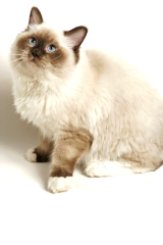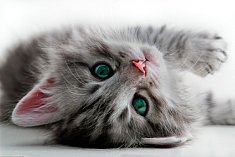|
Feline Arthritis: Causes, Symptoms And Treatments

Feline Arthritis is a general inflammation of the joints in cats, which causes painful aching in their joints. A cat who once gracefully leapt from carpet to counter or up the stairs, as a result of the pain and discomfort of the disease, may have difficulty simply walking. Here we will discuss the causes, symptoms and different treatment options for the disease.
Causes
There are several different causes for feline arthritis, however the main cause appears to be due to elderly cat health problems. As any mammal ages, the once strong cartilage that protects the bones where they meet, the joints, breaks down and is repaired by the body in a less organized fashion. The newer cartilage formations are often irregular and weaker than cartilage produced at the beginning stages of our lives. As a result of the weaker cartilage protection, the movement of the bones can cause both pain and inflammation at the joints. Cats are most susceptible to feline arthritis in their shoulders, elbows, hips, and ankles. Nonetheless, any joint is a candidate for arthritis, even those of the spine. Feline arthritis can also be caused by accidents such as; sprains of the limbs or bone fractures, which can weaken the joints and can cause an onset of arthritis. Feline obesity can also make cats more susceptible to arthritis due to the excess amount of body mass their bones must support.
Behavior Changes
Imagine your body aching intensely, and each step you take is more painful than the step before (some of us might already know the feeling). This is what a cat suffering from arthritis feels every time they move their body, which explains why their behaviors can change so drastically. Similar to humans who may fall into depression as a result of an illness, cats with arthritis or any other cat health problem cat health problem can go through similar responses. Cats love to freely move around, which includes running, jumping and even climbing; feline arthritis makes these pleasurable activities very difficult to do. Cats suffering from arthritis might display any of the following symptoms: depression in mood or character; general decline in mobility; shifts in typical behaviour (not using their litter box because it is painful to climb in, refusing their favourite spot on the couch because it is too high to leap) an alteration in the way your cat walks; apparent stiffness during or before movement. Your cat may also exhibit aggressive behaviours such as cat biting, scratching and hissing when touch as a result of the discomfort their experiencing. It’s important to recognize these symptoms as they appear, clearly record them, and report them to your cat's veterinarian. .
Treatment Options
To diagnosed feline arthritis your vet will conduct a physical examination, blood work, ultrasound, radiographs and other test to confirm the diagnosis. A common medical treatment for feline arthritis is Cosequin. Cosequin is an ingestible powder containing Glucosamine (a material used in the formation of cartilage) and Chondroitin (a supplement that strengthens cartilage, preventing enzymes from breaking the cartilage down). In accelerated cases of feline arthritis, a veterinarian may prescribe anti-inflammatory drugs such as Corticosteroids. Although these drugs bring down inflammation in the joints, they are also associated with a number of adverse side-effects and is therefore used only has a last resort. All natural vitamins also help to reduce the discomfort of sore joints. They are filled with minerals that can help to soothe those aching joints and reduce inflammation. Acupuncture sessions are also a natural recommended way to relieve pain and discomfort for your cat.
Where Can I Buy All Natural Cat Arthritis Joint Discomfort Relief
Making Your Cat Feel Comfortable At Home
At home there are many changes you can make in your cat’s life to help them live as comfortable as possible with this illness. If your cat is overweight, your vet will recommend that your cat be placed on a weight loss program, this may include changing your cat’s food or reducing the portion sizes. It’s important that your vet assist in placing your cat on a weight loss plan and that you don’t just do it alone, your vet will be able to properly implement a program that does not reduce the necessary vitamins and nutrients your cat needs on a daily basis. If your cat’s favourite spot is next to you on the couch, consider buying a nice two-stair step leading up to the cushion, to make it easier for your cat to reach that spot without having to jump. Try to keep everything your cat uses on the main floor of the house to eliminate unnecessary trips climbing or descending stairs. If your cat spends a lot of their time in the lower part of the house, make sure that their litter box, food and water is also available to them. An open litter box is highly recommended, it's much easier for your cat, who may experience difficulties going in and out of a closed litter box. It is important to make sure that your cat’s environment it at a comfortable warm temperature, including their bedding, it helps to soothe their joints. Buying a heated cat bed is a good way to keep your cat bedding warm. Keeping your cat active is also an important part of treating the disease, your cat may not want to participate in playing, but it’s essential to involve your cat in short play sessions to keep their joints from stiffening up. Buy cat toys or make ones that entices your cat into
Similar Topics
Feline Lymphoma: Causes, Symptoms, Treatment - Discussing the cause, symptoms and treatment of feline lymphoma
Symptoms And Treatments For Diabetes In Cats -How To Identify And Treat Diabetes in Cats.
Return From Feline Arthritis To Cat Health Home Page
|
Protect Your Pet Card
In Case Of An Emergency The Protect Your Pet Card Lets Emergency Services Know That You Have Pet/Pets Waiting For You At Home, Making Sure That Your Pets Are Cared For.
Get Your Card Today!
Win A Free $250 Petsmart Gift Card For Your Cat!
Must Be A US Resident
Click Here To Easily Enter For Your Chance To Win.

"There are few things in life more heartwarming than to be welcomed by a cat."






